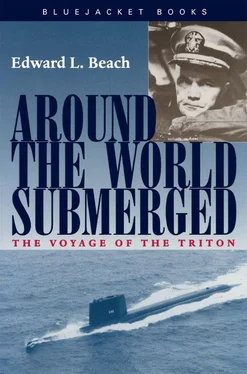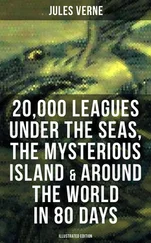According to Triton’ s Log, shortly after completion of the general drills on that same day a message from New London informed us that Richard W. Steeley, Engineman Third Class, had become the father of a baby girl. The message, in duplicate, was brought directly to me from the radio room, but instead of sending immediately for Steeley, I sent instead for Jim Smith, Seaman First Class. Almost every ship has a cartoonist or artist of some kind. Smith was ours. By the time Steeley arrived to get the good news, Smith was gone. One dispatch form, labeled “Mother’s Copy,” was duly decorated with cupids and hearts and flowers. The carbon copy, marked “Father’s,” had two ugly pot-bellied old men.
Steeley had evidently been on watch in the engineering spaces when the summons for him arrived, but the self-conscious grin of happy relief on his face more than made up for the smudges and perspiration which were also there. Mother and daughter, the message stated, were fine—baby’s name: Bonnie Lynne.
One of the advantages of our new Kollmorgen celestial navigation periscope was the elimination of the need for a horizon. The periscope computes its own horizon; thus observations of sun, stars, or the moon can be made at any time the celestial bodies can be seen. Just after midnight, on the morning of the nineteenth of February, we had Triton back at periscope depth for a fix and ventilation. This fix, when computed, showed us to be short of our PIM (position of intended movement). In preparation for the voyage, a detailed track chart with our exact routing and the times we were supposed to pass through each point had been left with ComSubLant, so he would always know our exact position. Loss of time getting the feel of our ship, learning the techniques of getting some of the observations expected of us, and the somewhat reduced speed necessary for recent repairs had caused us to fall behind schedule. But for Triton, this was no serious problem. With a slight increase in power, our submarine cruiser began to tear through the water at a speed few ships could match, even on the surface. And but for the roar of steam passing through her turbines, there was no sensation of speed at all.
On this day, also, we released our first hydrographic bottle, a procedure we would carry out twice a day throughout the remainder of the trip. The United States Hydrographic Office has a standard form, available to all US merchant and naval vessels, which requests that at appropriate times the form be filled out, sealed in a bottle, and dropped over the side. The so called “bottle paper,” printed in several languages, simply asks the finder to note the time and place it was found, in the blanks provided, and to forward the paper to the nearest US government authority. We could not, of course, surface to put the bottles into the water, but this turned out to be a very easy problem to solve. A standard medical bottle easily fitted into our submerged signal ejector (we had previously tested one to full submergence pressure with no apparent bad effects), and to release it we had only to shut the inner cap, equalize to sea pressure by opening a valve in an equalizer line, then open the outer cap. The bottle floated out on its own buoyancy and within a short time reached the surface.
Concern over possible premature discovery of one of these bottles, however, had prompted a certain amount of circumspection in Washington. We had been directed not to fill out the bottle papers completely and under no circumstances to put the name, Triton, anywhere on them. They were, as a consequence, filled out in a simple code. To assure authenticity, each was written in duplicate, with the carbon copy preserved for later transmittal to the Hydrographic Office.
Another important event of this portion of our cruise was recorded when the Triton Eagle began publication with a four-page issue of fifteen copies. The stated objectives of this daily newspaper were to publish news (received by the editor on our radio and transcribed directly by typewriter to the master copy), editorials (conceived by the editor and typed then and there on the master copy), jokes (thought up by the editor or possibly handed in by someone else and transcribed directly on the master copy), humorous happenings on board (related to the editor and likewise taken down verbatim), and cartoons (drawn by the originator directly on the master copy). In an attempt to be useful to all hands, the first issue contained the following sample letter home, recommended to everyone as a start:
LETTER HOME
We dove to a depth of ( classified ) and turned the ship toward ( classified ). We rang up speed for ( classified ) while the pressure on the hull was ( classified ). I went aft to check our ( classified ) and passed a civilian from ( classified ) who was riding us to check on ( classified ). About this time Dr. ( classified ) from ( classified ) asked me to step into the ( classified ) to fill out a form concerning ( classified ). Hope to see you in about ( classified ) days.
Love to you and the kids, (
Classified )
As in most naval ships, for fairly obvious reasons, the editor of the newspaper was a radioman; in our case, Radioman First Class Harold J. Marley, Jr. His assistant and general factotum was Audley R. Wilson, Radarman First. A third member of the staff occasionally contributed a column and rendered assistance in certain important ways, such as selection of periscope depth periods to coincide with the best news broadcasts, but refused the honor of being listed as a contributor because of his official position as Commanding Officer.
We had only been at sea a few days when a serious deficiency in the ship’s ventilation system came to light. Our SINS had been installed in a compartment which used to be a provisions storeroom, and unfortunately the addition of a considerable amount of high-powered electrical equipment had not been accompanied by enough air-conditioning. As a consequence of the slowly increasing warmth of the sea on our way south, the ex-storeroom had kept creeping up in temperature. George Troffer, who as Electrical Officer had responsibility for the SINS, became increasingly concerned as the temperature increased, rose in rebellion when it reached 105° F. Something had to be done, he said, to protect the precious equipment. Specifically, some auxiliary ventilation had to be provided quickly. It wasn’t the discomfort of the Electrician’s Mates keeping watch on the SINS that bothered us, for our men could stand that with never a complaint. The problem was that the tubes and circuitry of the equipment were not built to withstand continual high temperatures.
Several alternative ideas were discussed, and then Triton’s submarine jury-riggers turned to with a will. After several hours of cutting and bending sheet metal and squeezing a collapsible duct into a confined space alongside one of our radar masts, a cool air supply was channeled into the compartment, reducing the ambient temperature in the vicinity of the SINS to 90° F.
The problem was by no means a new one to submarines, nor was the solution; and I was in the end glad it happened. Nothing is better for the crew of a ship, particularly a new ship, than to have a difficult problem to solve, and to solve it efficiently.
A day or two later, as Triton’s mighty engines drove her deep under the ever-warming sea, trouble of another kind arose. This time it was a jammed outer door on our garbage ejector. During the war, it was customary to bag the garbage in weighted sacks and carry it to the bridge right after surfacing every night (one submarine early in 1942 did not do this, instead kept all of it on board during an entire patrol—and raised an unholy stink in Pearl Harbor when the hatches were opened upon her return). The problem created by the continuous submergence of our new submarines had been solved by a small-diameter torpedo tube, mounted vertically, with a watertight and pressure-proof closure or “door” at each end. All garbage and trash was packed into the ejection tube through the open breech door, while an interlock system made it theoretically impossible to open the outer door until the inner one was properly locked shut, and then the positions of the doors were reversed for flushing.
Читать дальше












